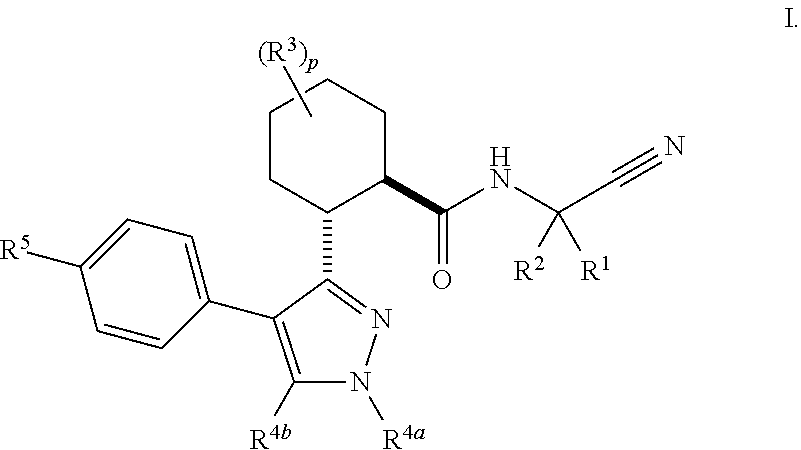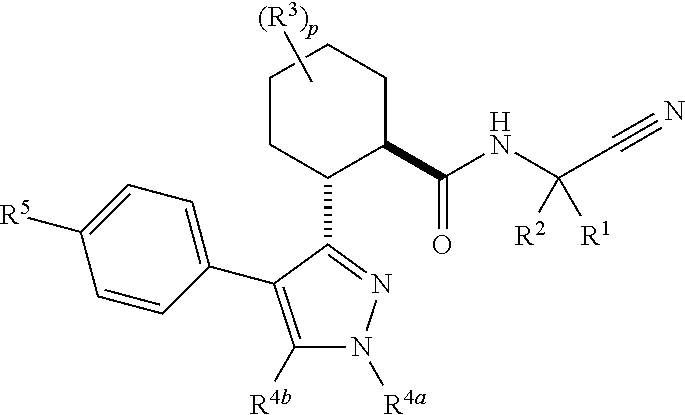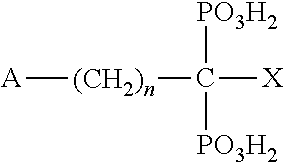Cathepsin cysteine protease inhibitors
a cathepsin cysteine protease and protease inhibitor technology, applied in the field of cathepsin cysteine protease inhibitors, can solve the problems of high risk of fracture, large segment of the older population already has low bone density, and morbidity and mortality in the elderly population
- Summary
- Abstract
- Description
- Claims
- Application Information
AI Technical Summary
Benefits of technology
Problems solved by technology
Method used
Image
Examples
example 1
[0303]
(1R,2R)—N-(1-Cyanocyclopropyl)-2-(4-(4-(4-cyanopiperidin-1-yl)phenyl)-1-(4-fluorophenyl)-1H-pyrazol-3-yl)cyclohexanecarboxamide (Compound 1)
Step A: (1R,2R)-Methyl 2-formylcyclohexanecarboxylate
[0304]Oxalyl chloride (25.3 g, 201 mmol, 1.50 equiv) was added dropwise to a solution of (1R,2R)-2-(methoxycarbonyl)cyclohexanecarboxylic acid (25.0 g, 134 mmol, 1.00 equiv) in dichloromethane (30.0 mL) followed by the addition of one drop of DMF at 0° C. The resulting solution was stirred for 3 h at ambient temperature. The solution was concentrated under reduced pressure to give (1R,2R)-methyl 2-(chlorocarbonyl)cyclohexanecarboxylate as a semi-solid that was dissolved in THF (30.0 mL). To the above solution were added 2,6-dimethylpyridine (21.5 g, 201 mmol, 1.50 equiv) and palladium on carbon (10%, 2.00 g, 16.7 mmol, 0.125 equiv). The flask was degassed and back-filled with hydrogen 3 times and stirred under hydrogen balloon for 16 h at ambient temperature. The solids were filtered out...
example 2
[0314]
(1R,2R)—N-(1-Cyanocyclopropyl)-2-(4-(4-(1,1-dioxidothiomorpholino)phenyl)-1-(3-methoxyphenyl)-1H-pyrazol-3-yl)cyclohexanecarboxamide (Compound 2)
Step A: (1R,2R)-Methyl 2-(4-bromo-1-(3-methoxyphenyl)-1H-pyrazol-3-yl)cyclohexanecarboxylate
[0315](1R,2R)-Methyl 2-(4-bromo-1-(3-methoxyphenyl)-1H-pyrazol-3-yl)cyclohexanecarboxylate was synthesized following the same procedure as in Step E of Example 1 using pyridine (32.0 mg, 0.440 mmol, 2.00 equiv), (1R,2R)-methyl 2-(4-bromo-1H-pyrazol-3-yl)cyclohexanecarboxylate (62.0 mg, 0.220 mmol, 1.00 equiv), (3-methoxyphenyl)boronic acid (65.6 mg, 0.440 mmol, 2.00 equiv), CH2Cl2 (2.0 mL) and Cu(OAc)2 (59.0 mg, 0.330 mmol, 1.50 equiv). This resulted in (1R,2R)-methyl 2-(4-bromo-1-(3-methoxyphenyl)-1H-pyrazol-3-yl)cyclohexanecarboxylate as a yellow oil. MS (ES, m / z): 578.3 (M+1).
Step B: (1R,2R)-Methyl 2-(4-(4-(1,1-dioxidothiomorpholino)phenyl)-1-(3-methoxyphenyl)-1H-pyrazol-3-yl)cyclohexanecarboxylate
[0316](1R,2R)-methyl 2-(4-(4-(1,1-dioxidothi...
example 3 and example 4
[0319]
(1S or 1R,3R,4R,6R or 6S)—N-(1-Cyanocyclopropyl)-4-(4-(4-(1,1-dioxidothiomorpholino)phenyl)-1-(4-fluorophenyl)-1H-pyrazol-3-yl)bicyclo[4.1.0]heptane-3-carboxamide (Compound 3)
(1R or 1S,3R,4R,6S or 6R)—N-(1-Cyanocyclopropyl)-4-(4-(4-(1,1-dioxidothiomorpholino)phenyl)-1-(4-fluorophenyl)-1H-pyrazol-3-yl)bicyclo[4.1.0]heptane-3-carboxamide (Compound 4)
Step A: (3R,4R)-Methyl 4-formylbicyclo[4.1.0]heptane-3-carboxylate
[0320]Oxalyl chloride (1.91 g, 15.1 mmol, 1.50 equiv) was added dropwise into a stirring solution of (3R,4R)-4-(methoxycarbonyl)bicyclo[4.1.0]heptane-3-carboxylic acid (2.00 g, 10.0 mmol, 1.00 equiv) in DCM (30 mL) and DMF (5.00 mg, cat.) at 0° C. The resulting mixture was stirred at RT for 3 h. The mixture was concentrated under reduced pressure. The residue was dissolved in THF (30 mL), and 2,6-lutidine (1.62 g, 15.1 mmol, 1.50 equiv) and Pd / C (10%) (0.200 g, cat.) were added to the solution. The resulting mixture was degassed with N2 for 3 times and stirred under H2...
PUM
 Login to View More
Login to View More Abstract
Description
Claims
Application Information
 Login to View More
Login to View More - R&D
- Intellectual Property
- Life Sciences
- Materials
- Tech Scout
- Unparalleled Data Quality
- Higher Quality Content
- 60% Fewer Hallucinations
Browse by: Latest US Patents, China's latest patents, Technical Efficacy Thesaurus, Application Domain, Technology Topic, Popular Technical Reports.
© 2025 PatSnap. All rights reserved.Legal|Privacy policy|Modern Slavery Act Transparency Statement|Sitemap|About US| Contact US: help@patsnap.com



